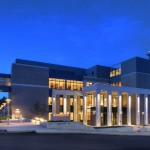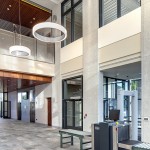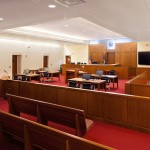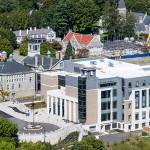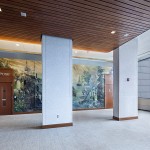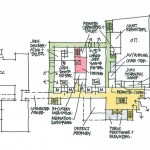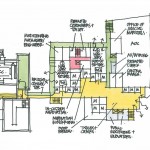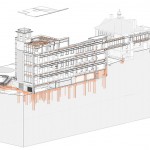Capital Judicial Center
Project Name
The 120,000-sf courthouse sits on a dramatic sloping site above the City of Augusta, within sight of the statehouse dome. Planned as a consolidated court, the building combines district and superior courts with the Administrative Office of the Courts and other court functions. It is connected to the historic Kennebec County Court by a 3rd-story bridge, which provides secure access to the ceremonial courtroom, which will continue to be used for ceremonial occasions.
The design combines traditional durable courthouse materials with a concern for the dignity and privacy of the public, providing natural light in all public spaces and a variety of waiting and conference spaces. The same elegance pervades office and work areas, which take advantage of beautiful views north, south, and east to the Kennebec River. Several Percent for Art works, including a mural by Christopher Cart, depict the Kennebec River and its history. The sloping nature of the site made it possible to tuck a story of staff parking and secure detainee transport under the building.
The design observes ideal courthouse planning principles, with separate, secure circulation for staff, detainees, and the judiciary. High efficiency zone heating and cooling is provided by chilled beams and radiant floor heating. Other high-efficiency features include water-saving fixtures; a white reflective roof; highly efficient windows; LED lighting; CO2 sensors to direct the delivery of fresh air; insulation with high recycled content; and a high-performance envelope.
Architecture or A/E Firm Name
Architect
Team
Consultants
Location
Client
General Contractor
MEASURE 1: DESIGN & INNOVATION
●The program consolidates functions and staff of 4 outdated facilities into 1 energy-efficient building ●Court client specifically requested copious daylighting in public spaces, citing mood-altering effects on people under stress; south-facing entry provides a warm entry procession for visitors ●17-20% slope of the site allowed for multiple access points; secure parking underneath the first floor reduced need for impervious parking
MEASURE 2: REGIONAL COMMUNITY DESIGN
●Architectural design and materials respond to the neighborhood of 19th-century granite and brick civic and downtown buildings ●Building responds to views of the river (east) and the statehouse (south) ●Integration of % for Art projects, which depict local culture and natural features
MEASURE 3: LAND USE & SITE ECOLOGY
●Reuse of previously developed urban brownfield site ●Full cut-off exterior lighting protects the night sky
MEASURE 4: BIOCLIMATIC DESIGN
●People working in the building enter from secure covered parking ●White high-albedo roof reduces heat-island effect ●Easy public access: bus stop on corner of site, bike racks and storage, outdoor public stair to downtown and river trail
MEASURE 5: LIGHT & AIR
●Copious amounts of natural light in public spaces on the south side of the building without compromising energy efficiency through use of high-performance glazing ●Offices grouped on the east side to take advantage of morning light and spectacular river views ●Fresh air provided through demand control ventilation, which reduces ventilation load when the building is partially occupied ●Dedicated outdoor air systems (DOAS) with heat recovery units at an efficiency of 79%
MEASURE 6: WATER CYCLE
●All stormwater treated onsite ●Water-conserving low-flow bathroom and kitchen fixtures, point-of-use hot water heaters ●Water-efficient landscaping and no irrigation
MEASURE 7: ENERGY FLOWS & ENERGY FUTURE
●EnergyStar Statement of Energy Design Intent score of 96; heated and cooled with a natural gas chilled beam system; condensing boilers with an efficiency of 96%; worked with the city during negotiations with gas company to anticipate demand for natural gas ●Exterior envelope design has continuous 3.5-inch mineral wool insulation with R5 value ●Dual wheel heat recovery units on DOAS systems provide dehumidification to reduce the load on the cooling system
MEASURE 8: MATERIALS & CONSTRUCTION
●Recycled, regional, rapidly renewing, and low-emitting materials, certified wood ● Indoor high-efficiency lighting with occupancy sensors target 0.7 watts/sf ●Sit-to-stand workstations with LED task lights with automatic shutoff
MEASURE 9: LONG TERM FLEXIBILITY AND ADAPTABILITY
●Designed to be a 100-year building with durable materials, interior flexibility, connection to urban fabric ●Demountable integrated mobile wall system (DIRTT) for offices and conference rooms is easy to reconfigure ●The new building provides access by a bridge to the 1830 Kennebec County Courthouse, which reopens the now-restored historic ceremonial courtroom for the first time in 40 years.
MEASURE 10: COLLECTIVE WISDOM & FEEDBACK LOOPS
●Produced a self-guided tour, rack cards, and green education posters for the lobby ●Energy management system to monitor energy use

